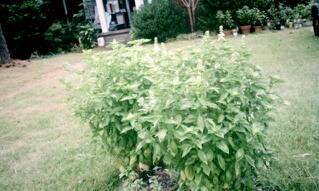Basil walnut pesto! Harvest time. Slow Food potluck today!
 Now that it's gotten cooler here in Columbia, South Carolina, I'm ready to harvest most of my sweet Genovese basil!
Now that it's gotten cooler here in Columbia, South Carolina, I'm ready to harvest most of my sweet Genovese basil!I've been cutting the flowering tops and seeds off of my plants for months, encouraging them to get bushy and full instead of leggy and gone to seed.
The tops make an easy, fragrant base for small floral arrangements, and the leaves will stay fresh in water for well beyond a few days in most cases.
I've been making these with zinnias from my garden all summer to put on the new communal bar table at Motor Supply Company Bistro in the Vista, in fact!
Just in time to make pesto for the fun, casual Slow Food Columbia potluck at the Indie Grits Festival launch party this afternoon, 4-7pm at Five Points Pub!
Our chapter of Slow Food USA is contributing potluck dishes to the party as part of the national "$5 Challenge" initiative to "Take Back the Value Meal."
Here's a link to a recent Washington Post piece featuring a Q + A on the $5 Challenge with Slow Food USA President Joel Viertel:
http://www.washingtonpost.com/blogs/all-we-can-eat/post/qanda-josh-viertel-of-slow-food-on-the-5-challenge/2011/09/14/gIQAoXU6SK_blog.html
Slow Food Columbia was pretty stoked to get the whole first page of the Life & Style section of The State newspaper recently, thanks to Slow Food-friendly writer Susan Ardis! Did you see it?
http://www.thestate.com/2011/09/07/1960787/throw-down.html
Notably, Slow Food Columbia members and friends try hard to adhere to Slow Food standards when cooking potluck meals for our events. The Washington Post piece sums it up nicely:
"It needs to fit the mission of slow food, which the group defines as 'food that is good for those who eat it, good for farmers and workers, and good for the planet.' As Viertel told me, 'We want to challenge people to cook slow food for the price of fast food."
The way we loosely define "Good, Clean and Fair" food when we're doing potlucks at Slow Food Columbia -- a volunteer-run nonprofit -- is that each dish should contain at least one major ingredient that was locally sourced and, ideally, produced sustainably and/or humanely.
There's an amazing sustainable food scene growing here in South Carolina, so it gets easier and more economical to cook this way each time a farmer or grocery store decides to walk the walk and spend the extra time and money required to be more green, eco-friendly, environmentally sound, sustainable, organic, or however you like to word it.
 My favorite pesto recipe comes from The Silver Spoon cookbook. It's simple and super flexible. Good news considering I am a chronic recipe fudger.
My favorite pesto recipe comes from The Silver Spoon cookbook. It's simple and super flexible. Good news considering I am a chronic recipe fudger.Pesto is wonderful in particular for recipe fudgers, as the ratios are very forgiving should you shift them in a wanton fashion.
My Rather Inexact Walnut Basil Pesto Recipe
Makes a sh*tload + freezes beautifully
I make 4 batches at once, based loosely on the above recipe.Then I freeze 1/2 cup - 1 cup at a time in Ziploc freezer bags or freezer-safe jelly jars.
TOASTED WALNUTS, chopped (or any nuts you want: pine nuts, pistachios, brazil nuts, pecans, whatever!)
First, I toast 3-4 cups of whole walnuts, which yields 2 cups of coarsely chopped walnuts. Toasting releases their oils, making them more delicious and delightful. It also makes them more susceptible to rancidity, so use them soon after toasting! Put them in the food-processor and jam down those nuts coarsely.
DECENT PARMESAN, shredded
Then I use the Cuisinart and shred a big hunk of good parmesan cheese to yield 3-4 measured cups. The recipe says to use a lot of parm, but I am a little more conservative and end up using half that. Rosewood Market, Columbia's only independently owned natural foods store and sustainable foods deli (hello, lemon-butter wild salmon on Mondays!) has good prices on better-than-decent Argentine Parmesan, which is way cheaper than the admittedly superior Parmigiano Reggiano.
GOOD OLIVE OIL
The better quality the olive oil, the tastier everything will be. 3 cups or so for a 4x batch. This is proven fact. The crummy olive oil at big-box groceries is nowhere near as floral, green, and delightful as high-end olive oil. THAT SAID, I'm trying to stick to the Slow Food $5 Challenge, so I'm going with the big tin of Earth Fare organic EVOO. It's just fine.
SALT, kosher or sea salt + PEPPER, fresh ground
A good pinch of each
Iodized salt doesn't hold one tiny candle to the subtle majesty of kosher salt. Kosher salt is also cheap as can be! I learned from the Zuni Cafe cookbook (SF institution of New Mediterranean cuisine) that kosher salt is less potent per portion than other salts, so adjust accordingly. Sea salt is lovely, too, but stronger.
FRESH-PICKED BASIL
100-150 leaves, e.g. 12-15 good, loose handfuls
Basil is ridiculously expensive in stores. Happily, it is ridiculously easy to grow giant bushes of it, given that you have a lot of regular sun and are willing to water it every few days during dry spells. I harvest not by pulling or cutting the whole plant; instead, I snip the tops for arrangements and grab bunches of leaves from the sides and pull, leaving the small, baby leaves that are just peeking out of the stem joints to grow into more delightful basil for my table.






Comments
Post a Comment